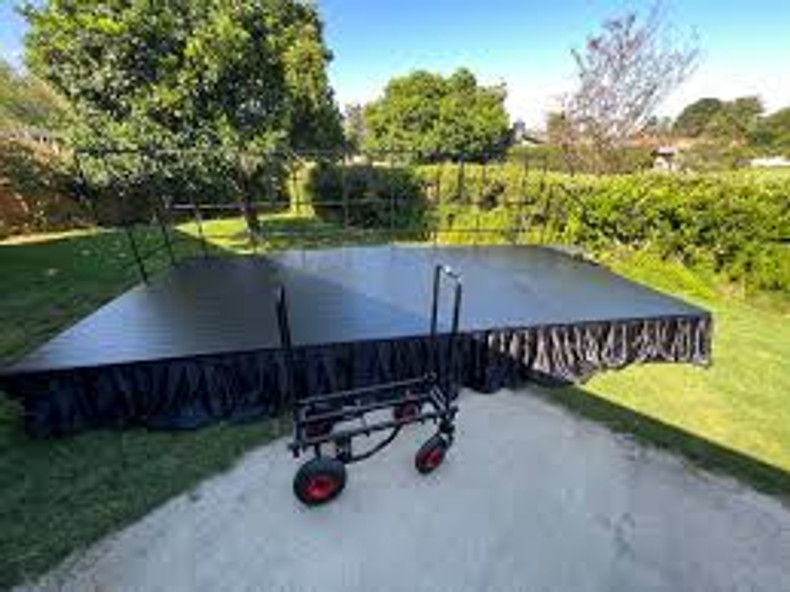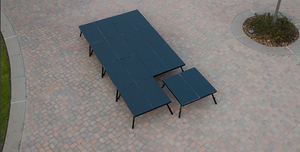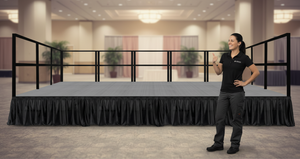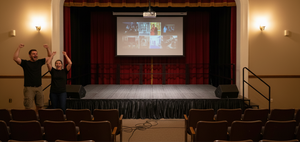Setting up and taking down a portable stage can seem daunting, especially if you're new to the process. However, it can be a smooth and efficient task with the proper guidance and some practical tips. In this ultimate guide, we’ll walk you through everything you need about portable stages, from understanding what they are to step-by-step assembly and disassembly instructions. Whether you're planning a concert, a theatrical performance, or a corporate event, this guide will ensure your portable stage setup is a success.
Introduction
The lighting, sound, and performance or presentation space are crucial to any successful event, but the stage is often the centerpiece. Portable stages have become famous for many event planners due to their versatility, ease of use, and cost-effectiveness. With a portable stage rental, you can create a professional setup adaptable to various venues and requirements.
This guide will provide detailed portable stage assembly instructions and help you understand the benefits and best practices for using modular stages, drum risers, and other essential components. By the end of this article, you’ll be well-equipped to handle your stage setup and take-down confidently.
What is a Portable Stage?
A portable stage is a versatile, temporary platform that is easily assembled and disassembled for various events. Unlike permanent stages, portable stages offer mobility and convenience, making them ideal for an event venue that regularly hosts different events. These stages typically consist of modular components such as stage decking, frames, and accessories like stage railings and skirting.
Portable stages come in various sizes and configurations, including the popular 4x4 portable stage modules, allowing a flexible event stage layout. Organizers can use them in multiple settings, from portable concert stages to corporate events, schools, and community performances. The ability to customize and expand these stages makes them a valuable asset for any event space planner.
Benefits of Using Portable Stages
Portable stages offer numerous advantages that significantly enhance event planning and execution. Here are some key benefits:
- Versatility: Portable stages can fit any venue and event type. Whether you need a small stage for a corporate presentation or an extensive setup for a concert, modular stages provide the flexibility to meet your specific needs. This versatility extends to various uses, such as drum risers, camera riser platforms, etc.
- Ease of Assembly and Disassembly: With clear portable stage assembly instructions, setting up and taking down your stage can be done quickly and efficiently, saving time and reducing the need for extensive labor, allowing you to focus on other essential aspects of event preparation.
- Cost-Effectiveness: Investing in a portable stage can be more economical in the long run than renting from a stage rental company for each event. Additionally, the ability to reuse and reconfigure the stage for different events increases its value.
- Durability and Safety: Modern portable stages can withstand heavy use and ensure the safety of performers and equipment. Features like stage railings and secure decking provide a stable and reliable platform.
- Compact Storage and Transport: Manufacturers design portable stages for easy transport and storage. When not in use, the components can be compactly packed and stored, freeing up valuable space and making them ideal for venues with limited storage capacity.
By choosing a portable stage, you gain a flexible and reliable solution that adapts to your event needs, enhances safety, and offers long-term cost savings. Whether you're setting up for a small local performance or a large-scale concert, portable stages provide the functionality and convenience to ensure your event's success.
Step-by-Step Guide to Setting Up a Portable Stage
Setting up a portable event stage design might seem challenging, but with the right approach and detailed instructions, you can have it ready quickly. Follow these steps to ensure a smooth and efficient setup process.
Unpack and Organize Stage Parts
The first step in setting up your portable stage is to unpack and organize all the components, which ensures you have everything you need and makes the assembly process more efficient.
Start by laying out all the stage parts in a clean, open area. Check the inventory list to ensure all pieces are present. Organize the components into groups, such as stage frames, decking, and accessories like railings and stage skirting. Everything neatly organized will save you time and help prevent any mix-ups during assembly.
Assemble the Stage Frame
With your parts organized, it's time to assemble the stage frame. The frame is the foundation of your stage, so it’s crucial to ensure it's sturdy and well-constructed.
Begin by connecting the frame pieces according to the portable stage assembly instructions. Most frames lock together easily without special tools. Make sure all connections are secure, and the frame is level. A stable frame is essential for the stage's safety and durability.
Add Stage Decking
Once you assemble the frame, the next step is to add the stage decking. The decking forms the surface of the stage where performances and activities will take place.
Carefully place the decking panels onto the frame, ensuring they are aligned correctly. Secure each panel according to the manufacturer’s instructions. For added stability, ensure you tightly fit the panels with no gaps. The decking should be flush with the frame edges for a professional look and safe performance area.
Secure the Stage for Stability
After the decking is in place, securing the stability stage is essential. This step ensures the stage remains safe and steady during use.
Use the provided hardware to anchor the stage to the ground if necessary. Check for any wobbling or uneven sections and adjust accordingly. Adding stage railings can also enhance safety, especially for higher stages. Stability is critical to preventing accidents and ensuring a smooth event.
Add Stage Accessories and Equipment
With the main structure secure, you can add any accessories and equipment needed for your event, such as drum risers, camera risers, lighting, and sound equipment.
Position and secure these accessories according to your event’s needs. Ensure you safely install all equipment and appropriately manage cables or wires to prevent tripping hazards. Accessories like stage skirting can give your stage a polished, professional appearance, hiding the frame and under-stage area from view.
Tips for Efficient Setup
To make the setup process even smoother, here are some practical tips:
- Pre-plan Your Layout: Before you begin, have a clear plan of your stage layout, as this helps organize the parts and speed up the assembly process.
- Work as a Team: Help can make setting up a stage easier. Assign specific tasks to each team member to streamline the process.
- Double-check Connections: Always double-check that all connections are secure and stable. A quick inspection can prevent issues during the event.
- Use Labels: Labeling stage parts and storage boxes can save time during setup and takedown. It makes organizing and finding parts much more manageable.
- Keep Instructions Handy: Always have the portable stage assembly instructions nearby. Refer to them as needed to ensure you’re following the correct steps.
Step-by-Step Guide to Taking Down a Portable Stage
Disassembling a portable stage is just as important as setting it up. Efficiently doing it ensures that all components remain in good condition and ready for use. Follow these steps to take down your stage quickly and safely.
Remove Accessories and Equipment
The first step in dismantling your portable stage is removing all accessories and equipment, including drum risers, camera risers, lighting, sound equipment, and stage railings.
Carefully detach and pack each accessory, wrapping delicate items to prevent damage. Coil and secure any cables to avoid tangling and tripping hazards. Removing accessories first makes it easier to disassemble the main stage components.
Take Down the Stage Decks and Frames
Once all accessories are safely stored, you can take down the stage decks and frames. Begin by carefully lifting and removing the decking panels. Be sure to handle them gently to avoid any damage or injury.
Next, disassemble the stage frame according to the portable stage assembly instructions. Typically, this involves unlocking connectors and carefully separating the frame sections. As you take down each part, organize them neatly to streamline the packing process.
Pack and Store Stage Components
After disassembling the stage, it's time to pack and store all the components. Place the decking panels, frame sections, and accessories into their respective storage cases or containers. Label each container for easy identification and future use.
Stack the components to maximize space and protect them from damage. Place the heavier items at the bottom and the lighter ones on top. Proper packing and storage extend your portable stage's lifespan and make future setups more efficient.
Tips for Efficient Take Down
To ensure the takedown process is as smooth as possible, consider these practical tips:
- Follow a Checklist: Create a checklist of all components and accessories. Check off each item as you pack it to ensure nothing is left behind.
- Work as a Team: Similar to the setup process, teamwork can expedite the takedown. Assign specific roles to each member to make the process more organized.
- Use Proper Tools: Ensure you have the necessary tools for disassembly, such as wrenches, screwdrivers, or other tools specified in the portable stage assembly instructions.
- Inspect Components: As you pack away each item, inspect it for any signs of wear or damage. Immediately addressing issues can prevent problems in future setups.
- Label and Organize: Clearly label each storage container’s contents, saving you time and hassle when setting up the stage for your next event.
Following these steps and tips, you can efficiently take down your portable stage, ensuring all components are safely stored and ready for future use.
Conclusion
Portable stages offer a versatile and practical solution for various events, providing the flexibility to adapt to different venues and requirements. Following the detailed steps outlined in this guide ensures that setting up and taking down your portable stage is smooth and efficient.
Understanding the importance of each component, from modular stages to stage railings, and utilizing the proper techniques enhances the safety and stability of your stage and extends its lifespan. Whether you're preparing for a concert, a corporate event, or any other gathering, having a reliable portable stage setup will ensure your event runs seamlessly.
Invest in a quality portable stage, follow the assembly and disassembly instructions, and you'll have a stage that meets your needs repeatedly. With proper care and organization, your portable stage will continue to provide a solid platform for countless successful events.






